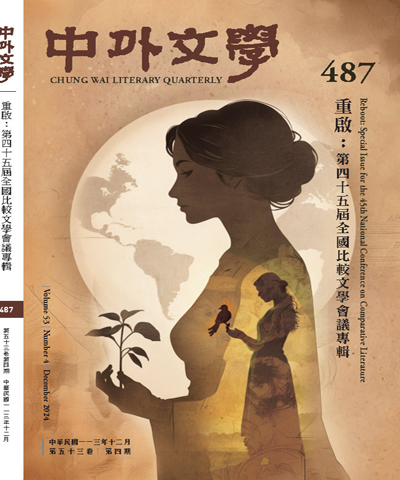
中外文學/CHUNG WAI LITERARY
國立臺灣大學外國語文學系,正常發行
選擇卷期
- 期刊
當代藝術家卡茨(Eduardo Kac)除了以媒體藝術聞名,也因為經常在作品中使用不同的生物體而頗具話題性,雖然其中不少作品乍看之下都像是迎合後現代風潮的戲耍之作,也不無以「讓觀者參與作品的完成」為噱頭的嫌疑,但長期投入動物研究的貝克(Steve Baker)認為卡茨的作品可以引領觀者去思考自身對他者的責任,提倡「後人文主義」思維的沃夫(Cary Wolfe)更表示,卡茨挑戰了人/動物二元對立的既定觀點,展現出後人文主義的關懷。卡茨的作品是否確如對他大加肯定的論者所言,並非只是譁眾取寵的後現代戲耍?本論文將以其數件運用了不同生物體的科技藝術作品為例,分兩大軸線進行論述:一方面探討卡茨如何回應「動物能否企近世界?」、「人如何企近動物經驗?」等傳統哲學所提出的質問;另一方面則思考卡茨的作品如何與「自生發」的概念對話,從而跳脫傳統再現手法的困境、開啟對於主客體的不同思考。透過本論文的探討,我們將能得知卡茨臆想「異類」的方式如何改變了人類中心的視野,乃至發展出後人文的倫理觀。
- 期刊
本文旨在闡述北美混血原住民作家歐溫斯(Louis Owens)混用偵探小說通俗文類、原住民神話與現代主義經典,經由三者的交織對話,不但顛覆純種原住民迷思,新創混血文本(mixedblood texts),且進而翻轉艾略特的荒原意象。文分五部。第一部份整理文獻,說明當代北美原住民文學理論將混血身份視為原住民文學的出發點。第二部份以第一本北美原住民小說《禾阿進歷險記》(The Life and Adventures of Joaquin Murieta, the Celebrated California Bandit, 1854)為例,說明北美原住民作家因為帝國殖民,混用白人文化的廉價小說通俗文類,進而析論北美原住民文學的混血(寫)屬性。第三部份轉向歐溫斯小說《至銳目光》(The Sharpest Sight, 1992),探討原住民偵探小說的文類混雜。第四部份分析《至銳目光》對現代主義經典荒原意象的運用。第五部份結論,指出歐溫斯身為混血原住民作家,不但將原住民神話、通俗文類、現代主義接枝混寫,並且以混血原住民身份重訪荒原,對艾略特的荒原意象有所新解,本文因稱「混血荒原」。
- 期刊
電影的當代境況變化急速,其物質媒介與展演形式不斷推陳出新。近年來,國內外各大現當代美術館紛紛投入動態影像藝術的展演乃及影片的委製與典藏,皆為意義深長也是非比尋常的跨界行動。蔡明亮的《臉》(2009)受羅浮宮邀約進駐拍攝,成為首部被收藏的影片。身為堅守藝術性與理想性的藝術家,蔡明亮這一部跨國創作尤其藉電影藝術與記憶、東西方文化典故及跨語際實踐等方略,形構電影如何以迥異其他藝術範型的影像形體,創造出一種既是影片生成為繪畫、也是繪畫幻化為影片的動靜遷徙。再者,在雜糅各種不同的記憶、文化及語言並對之進行重新組裝與配置之際,作為博物館-影片的《臉》不僅活化了現代電影與當代電影之間的歷史與美學遺贈,更開闢出一種以摻和與超越東西方影音文化構成的非純音像視域,作為建構電影記憶與嶄新生命的未來。換言之,《臉》超脫單一語系、族裔或文化共同體的華語影片概念,形塑了一座因結合跨文化圖像、跨媒介及跨藝術體制而湧現特殊性與造形性、異質性與生成性動能的跨影像之境。
- 期刊
本文以「後現代主義/後現代詩」在八○年代中期台灣現身並逐步被接受、正典化的過程為研究對象。八○年代中期,「後現代主義」之引進係以「後現代詩」為前導,首次在台灣登場。而「後現代詩」這個文類範疇的成立,是為了催生、合理化「台灣後現代狀況」的存在,而由羅青、林燿德、孟樊等人透過論述逐步「建構」而成的一個「新文類」。值得注意的是,在台灣「後現代詩」創建之初,與其透過國外作品的譯介,引介者更用力於從「現有的」「台灣戰後世代」的作品中去找尋所謂的「後現代詩/後現代狀況」。而「後現代」在台灣的引介並形成風潮,可視為台灣戰後出生世代作家崛起之初所搭的「順風車」,用以宣稱世代的新、世代的合法性,並試圖在僵固的文壇權力結構中突圍,重組文學版圖。其係一種對於「影響焦慮」的「超克」。藉著回顧八○年代中期「後現代」在台灣現身並逐步被正典化的過程,我們將發現:後現代理論在台灣的傳播,既是全球性知識流動的一個例證,同時也接枝上八○年代台灣社會經濟結構的轉型、戰後文學世代的崛起、以及解嚴後面臨的後殖民情境,成為一種在地化的「台灣後現代」。
- 期刊
明代醫療系統完備,建立起醫藥與食療論述,轉化為《西遊記》情節。誠然,小說頻頻歪讀醫療要旨,看似謬悠之說,但從醫者意也的視角,卻暗合多重隱喻。本文擬從醫藥與醫養兩方面進行探究,從中勾連身體觀,推廓出兩種指涉,其一為政治、社會層面的身體,由國王的病體,輻輳出官僚、社會的頹敗,醫藥儼然為治體/國處方;其二為長青文化的養生觀,無論是席宴中仙藥仙果作為諸仙裝備身體的贈禮,或是唐僧本身在食和性的系統體現長生意涵,以調笑之姿詮釋醫養敘事。由醫療戲言,映照出小說家含藏政權諷諭與宗教辯證的策略,允為文史醫學具表徵性的一種書寫。

